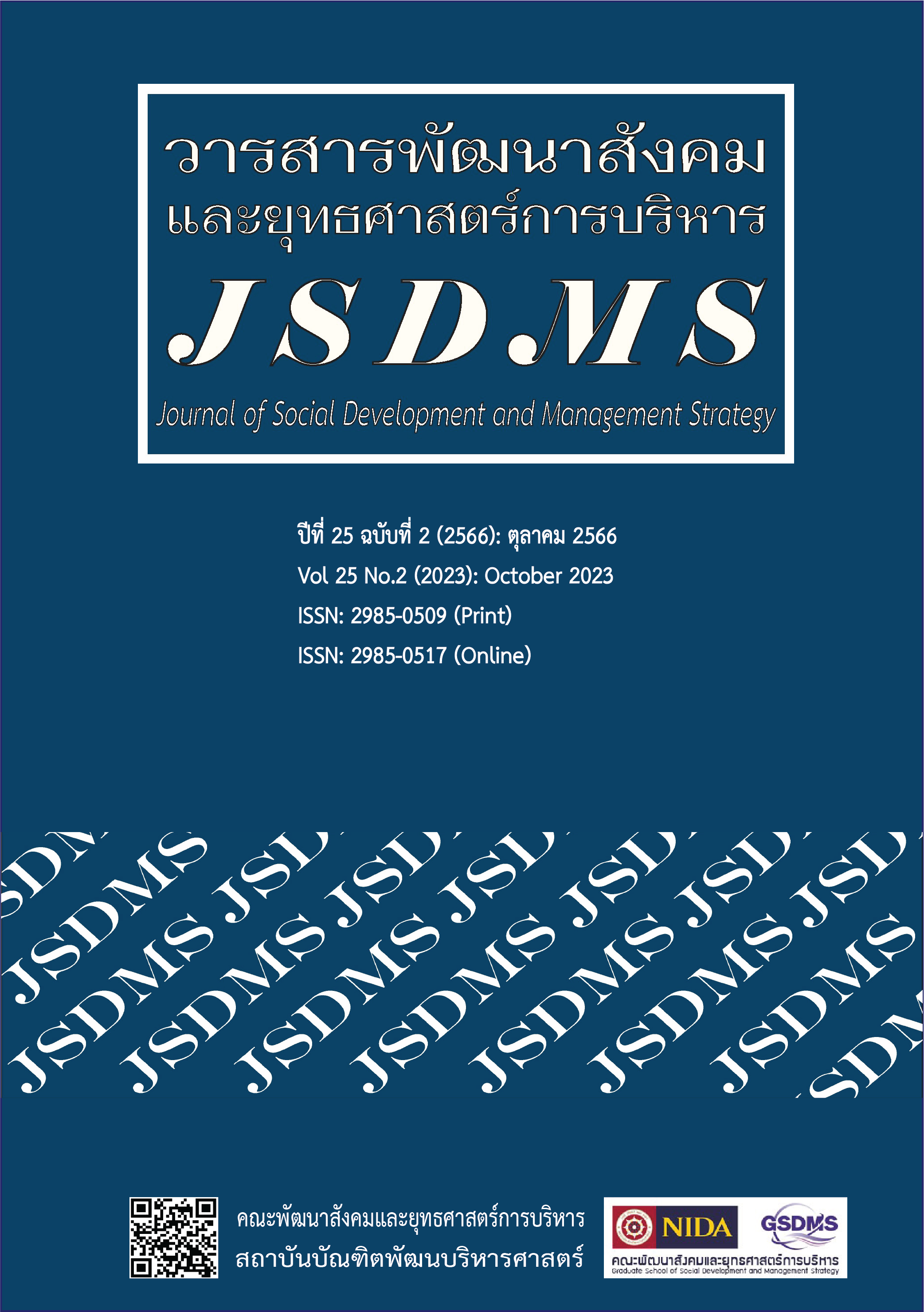การพัฒนาโมเดลเศรษฐกิจ BCG กับดัชนีอยู่เย็นเป็นสุข
Main Article Content
บทคัดย่อ
บทความนี้เน้นวิพากษ์โมเดลเศรษฐกิจ BCG (เศรษฐกิจชีวภาพ เศรษฐกิจหมุนเวียน เศรษฐกิจสีเขียว) ภายใต้กรอบแนวคิดทฤษฎีวิพากษ์ถึงช่องว่างที่ยังไม่ได้มีการระบุในแผนปฏิบัติการ ให้ตอบสนองเป้าประสงค์ของนโยบาย และยุทธศาสตร์การพัฒนาที่ต้องการให้ประเทศไทยเกิดความมั่งคง มั่งคั่ง และยั่งยืน โมเดลเศรษฐกิจ BCG จึงนับเป็นนโยบายที่มุ่งก่อให้เกิดการกระจายรายได้ โอกาส รวมถึงความมั่งคั่งแบบทั่วถึง ทั้งยังเป็นนโยบายสาธารณะที่สามารถส่งผลให้เกิดความสุขและความยั่งยืนแก่ประชาชนได้อย่างแท้จริง บทความนี้ศึกษาเอกสาร “แผนปฏิบัติการด้านการขับเคลื่อนการพัฒนาประเทศไทยด้วยโมเดลเศรษฐกิจ BCG พ.ศ. 2564 - 2570” และข้อมูลที่เผยแพร่ในเว็บไซต์ www.bcg.in.th ซึ่งเป็นช่องทางสื่อสารหลัก อีกทั้งบทความนี้ได้ดำเนินการศึกษาเปรียบเทียบความสอดคล้องต่อเนื่องของนโยบายโมเดลเศรษฐกิจ BCG (พ.ศ. 2564 - 2570) ภายใต้แผนยุทธศาสตร์ชาติ 20 ปี (พ.ศ. 2561 - 2580) โดยนำมาศึกษาวิเคราะห์เปรียบเทียบกับดัชนีอยู่เย็นเป็นสุขที่อยู่ภายใต้แผนพัฒนาเศรษฐกิจและสังคมแห่งชาติ ฉบับที่ 10 (พ.ศ. 2550 - 2554) ที่มุ่งพัฒนาสู่สังคมอยู่เย็นเป็นสุขร่วมกัน
จากการศึกษา พบว่า แม้เอกสารจะระบุว่าเป็นแผนปฏิบัติการด้านการขับเคลื่อนการพัฒนาประเทศไทยด้วยโมเดลเศรษฐกิจ BCG แต่ยังคงมีรายละเอียดแค่ระดับนโยบาย ยังไม่มีการลงรายละเอียดที่เป็นรูปธรรมในการขับเคลื่อน ยังไม่มีการระบุถึงความมุ่งมั่นในการก่อให้เกิดการกระจายรายได้ โอกาส รวมถึงความมั่งคั่งแบบทั่วถึง อย่างเป็นรูปธรรม เมื่อพิจารณาความสอดคล้องของโมเดลเศรษฐกิจ BCG กับดัชนีอยู่เย็นเป็นสุข มีสอดคล้องในองค์ประกอบที่ 4 คือ เศรษฐกิจเข้มแข็งและเป็นธรรม และองค์ประกอบที่ 3 ชุมชนเข้มแข็ง กับองค์ประกอบที่ 5 ในเรื่องสภาพแวดล้อมดีและระบบนิเวศที่สมดุล เท่านั้น มิติการปฏิรูปโครงสร้างทางสังคมได้ขาดหายไป ไม่ว่าจะเป็นองค์ประกอบที่ 1 การมีสุขภาวะ แม้ว่าจะมีสาขายุทธศาสตร์ที่ 2 ในเรื่องสุขภาพและการแพทย์ก็ตาม ซึ่งเป็นการตอบโจทย์ด้านการบริการเรื่องสุขภาพกายที่ดีเพียงอย่างเดียว ไม่มีเรื่องสุขภาพจิต คุณธรรม จริยธรรม การพัฒนาสติปัญญาและการใฝ่รู้ อีกทั้งการตอบโจทย์กับบางกลุ่มมากกว่าในทุกฐานะ ทุกรูปแบบ โดยที่องค์ประกอบที่ 2 ครอบครัวอบอุ่น และองค์ประกอบที่ 6 สังคมประชาธิปไตยที่มีธรรมภิบาล ไม่ได้ปรากฎในนโยบายและเอกสารปฏิบัติงานดังกล่าว
Article Details

อนุญาตภายใต้เงื่อนไข Creative Commons Attribution-NonCommercial-NoDerivatives 4.0 International License.
เอกสารอ้างอิง
Agricultural Land Reform Committee. (2011). Proposal for agricultural land management reform [in Thai]. Bangkok: TQP.
Anan Ganjanapan. (2000, November). Farmer's rights and resource management for sustainable development [In Thai]. Retrieved from
http://www.mcc.cmu.ac.th/Seminar/pdf/669.pdf
Bank of Thailand Learning Center. (2018, December 14). Tom Yum Kung Crisis in 2540 [In Thai]. Retrieved from
https://www.botlc.or.th/item/kc_recommendation/00000000014
Bank of Thailand. (2022, July). Headline inflation july 2565 [In Thai]. Retrieved from https://www.bot.or.th/Thai/MonetaryPolicy/Pages/OverviewInflation.aspx
Cabinet and Royal Gazette Publishing Office. (2008). Thailand cabinet policy statement [In Thai]. Bangkok: Cabinet and Royal Gazette Publishing Office.
Chalermchai Kittisaknawin, Kosin Techaniyom, Wutthichai Arakpothchong, & Worapol Pinit. (2563). Causal factors influencing the income distribution of middle income cointries and the relevance of governance indicators: International approaches to reduce inequality in Thailand [in Thai]. Bangkok: King Prajadhipok's Institute.
Ministry of Higher Education, Science, Research and Innovation. (2022, February). Bio-circular-green economy action plan 2564-2570
[In Thai]. Retrieved from https://www.bcg.in.th/bcg-action-plan/
Office of the National Economic and Social Development Council (2007). Supporting documents of the green and happiness in Thai society 2550 [In Thai]. Bangkok: Office of the National Economic and Social Development Council (NESDC).
NESDC. (2018). Thailand's 20-Year national strategy [In Thai]. Retrieved from http://nscr.nesdc.go.th/ns/
NESDC. (n.d.). The national economic and social development plan [In Thai]. Retrieved from https://www.nesdc.go.th/main.php?filename=develop_issue
Pakdee Rattanamuk. (2018). Thailand 4.0: Discover Thailand? [In Thai]. Bangkok: Panyachol Printing.
Pichai Ratnatilaka Na Bhuket. (2016). Critical theory [In Thai]. In Philosophy of social science: Foundation of social paradigms for social science research (2nd ed., pp. 173-188). Bangkok: Bangkok Block.
Puey Ungphakorn Institute for Economic Research. (2020, July 15). In depth analysis of Thailand three-decade-inequalities episode 1
[In Thai]. Retrieved from https://www.pier.or.th/abridged/2020/17/
Royal Gazette on the Issuance of Community Title Deeds B. E. 2553. Royal Thai Government Gazette, 127, 73 (11 June 2010), 1-4.
Suvit Maesincee. (2020, May 21). The world is changing; people are adopting: From breaking the traps to sustainability [In Thai]. Retrieved from https://www.nstda.or.th/home/knowledge_post/the-world-changes-people/
Thailand Science Research and Innovation. (2020, September 12). TSRI virtual forum 2563: EP.02 inequality time bomb national development traps [Video file]. Retrieved from https://www.youtube.com/watch?v=JzQTUivcm8s
The National Science and Technology Development Agency. (2021, February 6). Bioeconomy [in Thai]. Retrieved from https://www.bcg.in.th/bioeconomy/
United Nations. (2558). Transforming our world: the 2030 agenda for sustainable development. Retrieved from https://sdgs.un.org/2030agenda
Yos Santasombat. (2004). Ethnic ecology biological resources and community rights [In Thai]. Chiang Mai: Within Design.


